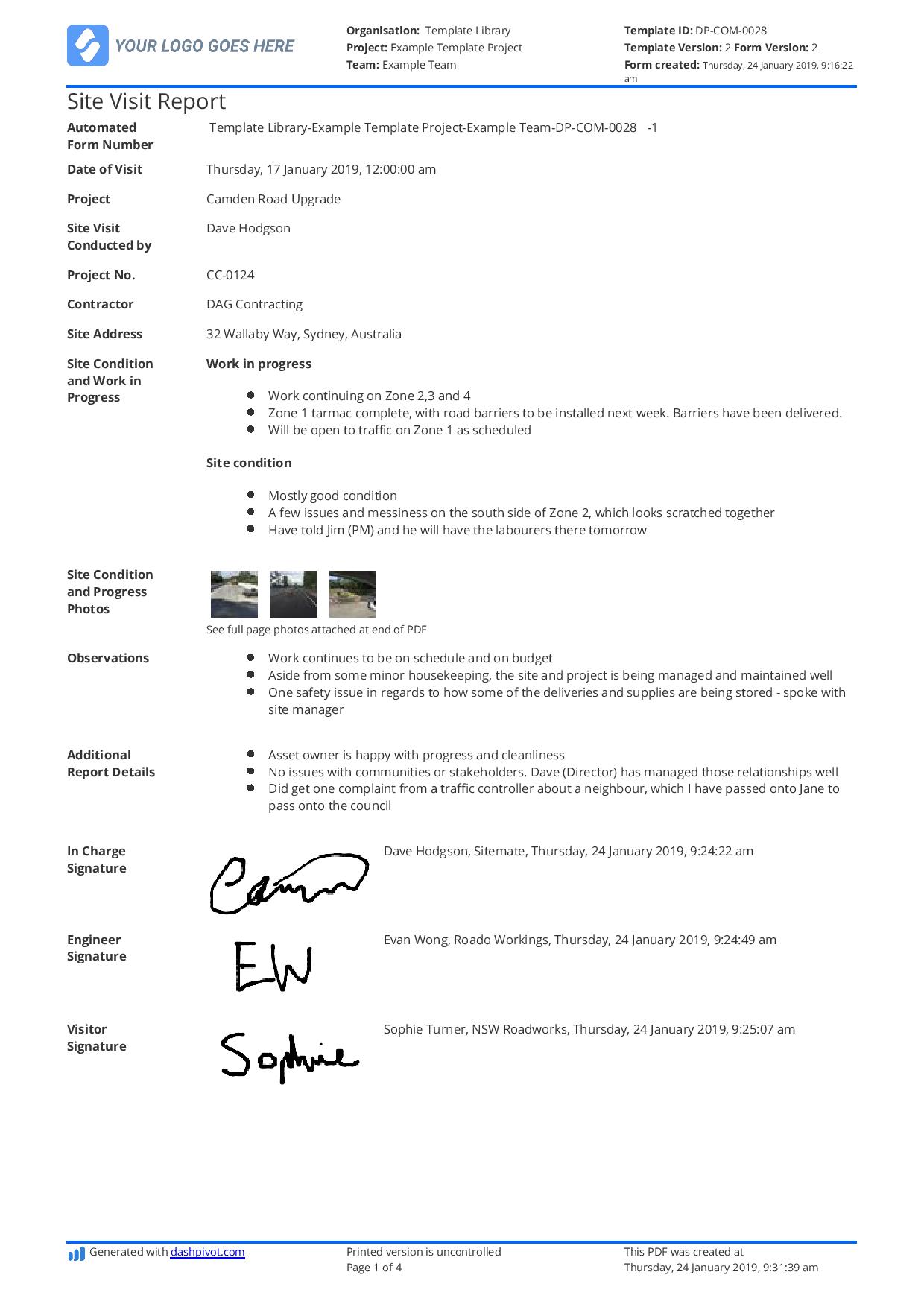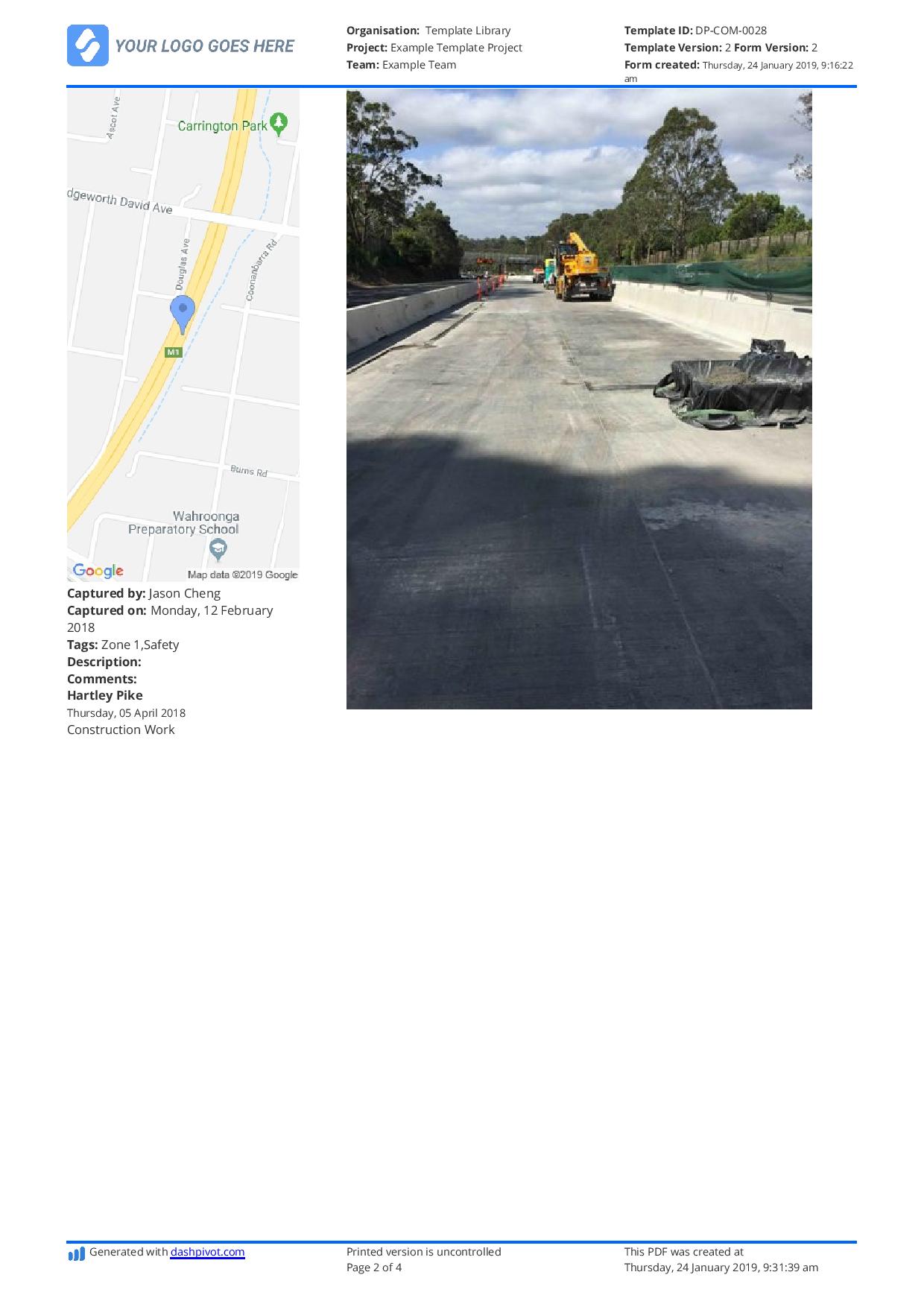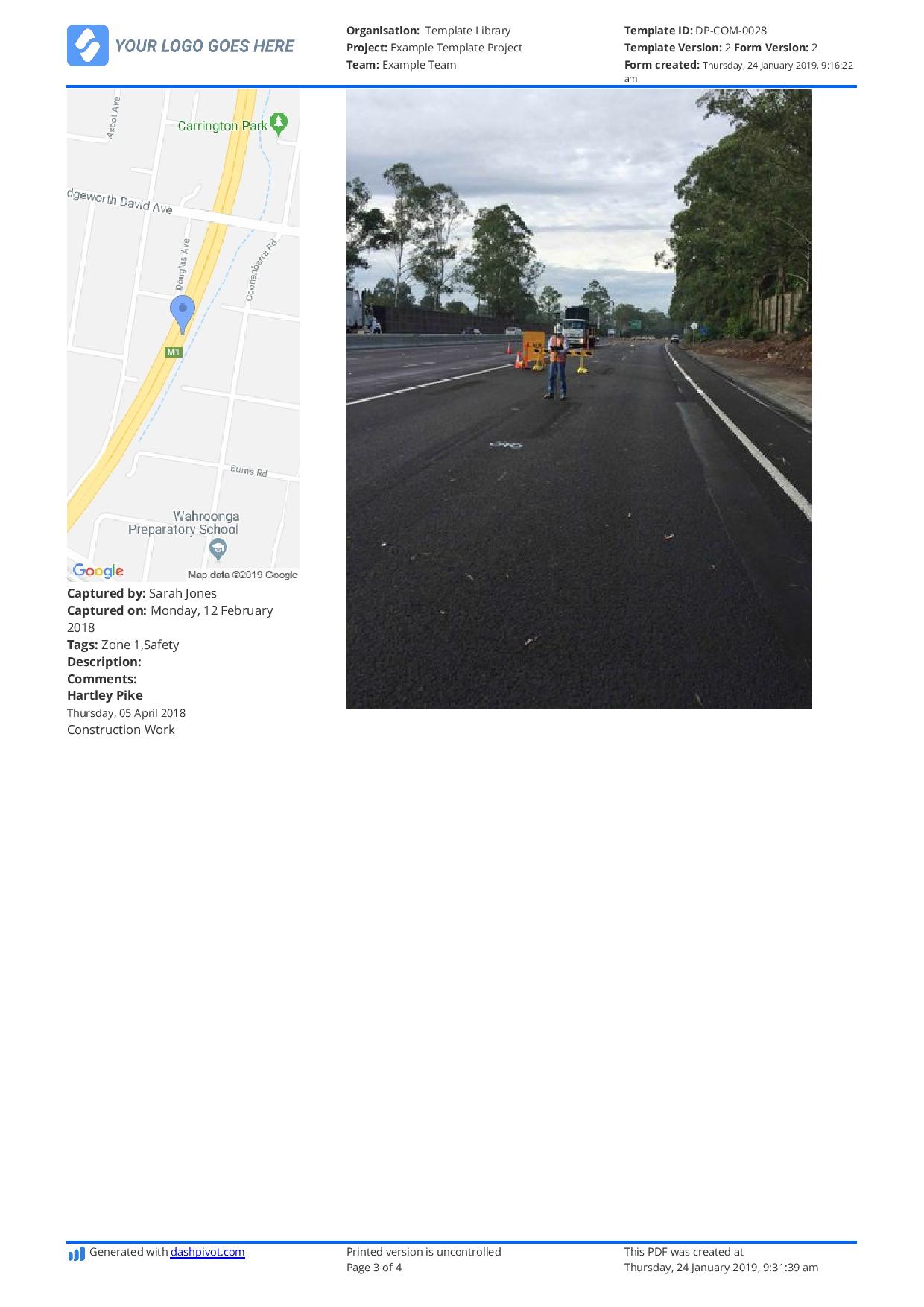Dashpivot article – Site Visit Report example

Site Visit Report example
What Are Some Examples of Site Visit Reports?
This article outlines some of the most common Site Visit Report examples in various industries or sectors in an industry such as in construction, engineering, health and safety, compliance, and many more. Each type of report has a different purpose and content but ultimately shares the same goal of providing detailed observations, and actionable and corrective actions.
A general site visit report contains general details of the project or site like the project name, site location, date of visit, inspector or visitor. The core details like the observations and corrective actions would vary from each type of site visit report and purpose or goal of the visit. The most important thing are these varied details as they outline the objective of the visit, which may also include the potential hazards and issues raised, whether the current processes are aligned to standards and compliances, and which corrective actions could better the current processes.
Examples of Site Visit Reports and Their Contents
What Does a Construction Site Visit Report Look Like?
Like any other site visit report, a construction site visit report contains all the detailed information regarding a project or site’s progress and safety conditions. For this type of site visit report, the objectives could range from checking the progress of the site/project construction, to evaluating and assessing whether current processes, activities, and materials are in compliance with safety and building codes.
In order to assess the project progress, safety, and compliance, the inspector must compare the ideal completed work to the current progress upon the site visit. A construction site visit report’s purpose is to hold all of the observations, hazards, deviations, photos, and recommendations in one document to make it easier for all stakeholders to evaluate and make informed decisions on the project or site. Checklists and other forms may be attached along with the construction site visit report in order to inspect if the site adheres to safety protocols, the work or processes meet the building codes and regulations, the workers are wearing PPEs and informed about the safety practices, and many more.
The observations in a construction site visit report should primarily focus on the progress of the project, the safety conditions being followed or not, and if compliance is consistent all throughout. These could be about the work progress and completed tasks, adding in details until completion. Inspectors may also include the quality and condition of the materials being used, their appropriate storage locations, and the use of proper and functional equipment on site. Observations may also include safety conditions and quality control, such as proper or improper use of gears, assessing if the actual construction progress meets the design specifications and local standards, and many more.
Attaching photos is a common practice in order to support the observations and provide clear proof to state issues that may be difficult to describe. Inspectors or individuals completing the construction site visit report usually use photos to show the project or site progress, to emphasise which locations are non-compliant with the safety standards, to highlight hazards and issues, to document discrepancies from the project plans, and indicate which sections have already been completed in the project.
One of the most essential sections of a construction site visit report is the “Recommendations” or “Corrective Actions”, which also includes the summary of the next steps to be taken in order to address hazards or issues found, or to efficiently perform tasks to align with the timeline. The summary may also indicate the next scheduled date for inspection and which areas should be prioritised during the said inspection.
Site Visit Report example and sample
Below is an example of a site visit report in action. You can use this example in its entirety or sample it as needed.

Use a free Site Visit Report template based on this Site Visit Report example
What Is an Environmental Site Visit Report?
An environmental site visit report is a report that documents the environmental conditions and if the processes and activities are in compliance with the local environmental regulations of a project or site. Similarly with other types of site visit reports, it contains the general detailed information.
What sets an environmental site visit report is that it is a document that includes the assessment of air, soil, and water quality, the possible and potential ecological impacts of the project, waste management practices and sustainable plans, and pollution control.
To formally and properly document on a project or site’s environmental compliance and lance conditions, the inspector must evaluate in all aspects whether they comply with the environmental regulations of the local authority.
Depending on the location, a more comprehensive inspection accompanied by authoritative bodies may be necessary. Inspectors must also check the waste disposal practices, emissions, and pollution control measures. Inspectors may regularly inspect whether the appropriate documents, permits, records for compliance with laws, and other similar documents are up-to-date and available.
In assessing the environmental factors, an environmental site visit report contains sections that includes observations and visual evidence (like photos) to document potential environmental risks in the surrounding areas, soil erosion, contamination, vegetation health, and the effects of the project and site activities to the nearby ecosystems. Environmental tests like water and soil samples may also be included or attached in an environmental site visit report.
Like a general site visit report, it’s essential to provide recommendations and corrective actions to improve site activities, use alternative methods to lessen and mitigate environmental impact and footprint, and resolve issues to achieve environmental standards.
What Should a Health and Safety Site Visit Report Contain?
A health and safety site visit report is a document that contains findings from workplace safety visits or inspections. It contains details and observations on the workplace safety conditions and whether they are or not in compliance with local health and safety regulations. This document is for visits that cover the assessment and evaluation of work practices, safety protocols, use of safe equipment, PPEs, and emergency preparedness.
Like other site visit reports, it contains detailed information regarding a project or site’s progress. As the conclusion, a health and safety site visit report finishes with a conclusion or recommendation section from the inspector to maybe address hazards or issues found, to improve safety protocols and measures, to review compliance documents, or purchase more safety equipment. They should be specific and actionable, with full details in order to communicate these information to all stakeholders involved.
To ensure that safety protocols are followed on-site, inspectors may interview personnel to review their understanding of all the safety protocols being practiced in the project or site. It is important that all personnel and employees are knowledgeable on the safety drills and emergency responses planned for the project. Should there be any violations or deviations, the inspector must indicate in the site visit report, including any photos or documents as supporting evidence, and provide recommendations and immediate corrective actions to address non-compliance. Aside from interacting with personnel, visual inspection on the work environment, PPEs, tools, machinery, safety signages, and accessibility of emergency exits, fire extinguishers, and first aid kits is also done.
A section to note the hazards should be in a health and safety site visit report, but it may also just be consolidated under the observations section. It could be physical hazards, chemical hazards, biological hazards, ergonomic hazards, fire hazards, or PPE violations. Hazards and corrective actions to address them should be monitored regularly for overall workplace safety and sustainability.
What Are the Next Steps for Improving Your Site Visit Reporting Process?
You and your team should use standardized templates that align with the different types of site visit reports you use regularly for your projects. They should include all the necessary information and key sections your project managers and site inspectors would need to assess and evaluate the condition of the projects such as the objectives, observations, recommendations, and conclusion.
Train personnel, staff, and employees to improve inspection and observation practices such as taking detailed and measurable data to ensure more accurate reports.
Speed up your reporting process by leveraging digital tools and using software for real-time data entry. Photo evidence should be practiced to provide clear visual evidence to support observations, hazards, issues, damages, and many more.

Site diary template
Complete and organise your daily diaries more efficiently.

Meeting Minutes template
Capture, record and organise those meeting minutes.

Progress Claim template
Streamline and automate the progress claim process to get paid faster and look more professional.

